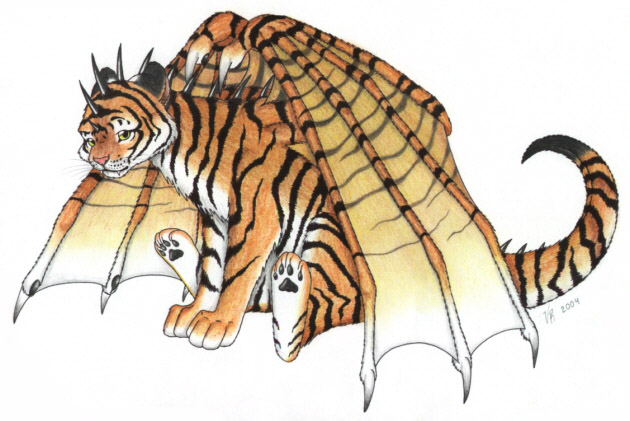The Monger-Goss Theory of Dragons and ABCs June 2, 2012
Author: Beach Combing | in : Actualite, Contemporary, Medieval, Modern , trackbackJust last week Beach was looking into dragon accounts from seventeenth century England. And in searching for dragon-related material he stumbled on an article that he feels deserves to be better known and perhaps celebrated. The article in question is George Monger’s ‘Dragons and Big Cats’ published in the illustrious journal of British myth and legend Folklore in 1992. Beachcombing is, to be honest, a little surprised that the article ever got through the doors of Folklore as the bouncers there are pretty rough fellows. But full credit to the editors at that time for letting something in that did not conform to the norms of academic folklore studies.
JM looks at the two dragon sightings that Beach described at the end of May and also an earlier medieval dragon sighting that Beach celebrated many a long moon ago, which sounds very much like an escaped crocodile. JM then compares these sightings with contemporary sightings of Alien Big Cats (jaguars, tigers etc) in the English countryside, that are often reported but never caught: suggesting that here too we are dealing with some sort of ‘mythic’ visions (i.e. human hardwiring gone wrong?).
JM then suggests that both dragon and ABC sightings (medieval and early modern) are seen under the same circumstances. In doing so he takes a list of criteria set out by scholar Michael Goss for ABCs, but that JM suggests works equally well for his dragons. This list, with full apologies to the gods of copyright, is printed below and might be interestingly applied to all kinds of cryptozoological sightings. It certainly provides food for thought though why, for example, should open land or driving/horse-riding be associated with creatures from the dark side?
1. An eyewitness account of a non-native animal. 2. The sighting is usually in an area of open land. 3. The encounter is usually brief, the witness may be on foot or riding (or motoring). 4. A description of the beast, often using familiar size indicators. 5. One sighting of the beast may be connected to others in the same area, which may be separated by days, months or years. 6. The animal may acquire a popular, or local, identification name. 7. Stated or tacit assumption that the beast is dangerous to humans (especially children) and livestock. 8. Physical evidence of the creature’s existence may be cited in the report. 9. Authority figures are quoted, which lends credibility to the report (even if the authorities comment negatively). 10. A report may suggest that the beast is an escapee from a zoo or wildlife collection. 11. A hunt is organised, which is usually unsuccessful. 12. The mystery beast suddenly disappears.
If JM is correct then people saw dragons in the seventeenth-century because there was still some residual belief in them. They saw on the other hand ABCs in the twentieth century because dragons were just no longer ‘possible’, apart from (maybe) in Wales. Any thoughts on the Goss-Monger theory? drbeachcombing AT yahoo DOT com
***
9 June 2012: JV writes: I would just like to object to the description of alien big cats as ”often reported but never caught”. In addition to real finds of tiger/lion/jaguar/leopard hair and droppings from a puma, there has actually been shot, over the years, one lynx and one puma. Granted, that’s no more than two, but those two were real cats; they’re not all phantoms. See ”British big cats: How good or bad is the evidence?” by Darren Naish on his old Tetrapod Zoology blog. Hyperborean comments ‘I read your post on the Monger-Goss theory with interest. It actually fits rather well with the speculations of David E. Jones who is an anthropologist at the University of Central Florida. In his book, _An Instinct for Dragons_, he suggests that the universiality of dragon myths dates back to our tree-living ancestors. He sees the dragon as an amalgam of the three main predators of such creatures: the snake, the bird of prey, and the big cat. The book is well worth reading, although I am not entirely persuaded.’ Wade, meanwhile, writes: The Monger-Goss Theory is interesting and parallels similar thinking in some UFO circles that UFOs aren’t real nuts and bolts objects, but rather extra dimensional projections or visions. But the problem with Monger-Goss are the photos. While a large portion of them seem to be regular-sized or larger-than-average moggies, I have seen some convincing photographic analysis in, I think, the Fortean Times, that at least some of the ABC images captured in the UK actually are real Big Cats. Unless you can photograph mythic visions, this leaves Monger-Goss – for me, at least – as another weak attempt to explain the inexplicable. Oh and I was trying to learn more about the Monger-Goss theory, if more is available, when I ran across this ScribD link which seems tangentially related, somehow. Thanks Wade, Hyperborean and JV!



